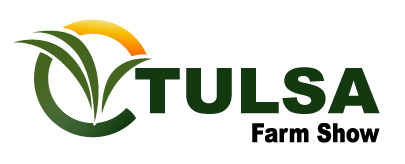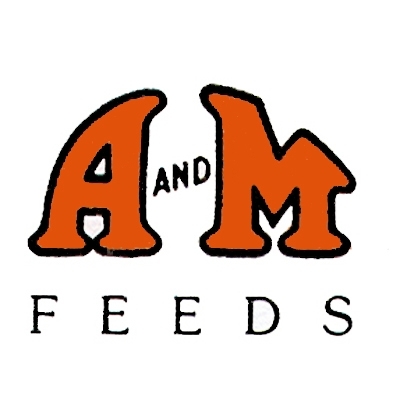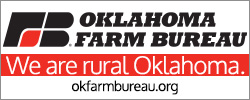|
Support Our Sponsors!

|
We invite you to listen to us on
great radio stations across the region on the Radio Oklahoma Network
weekdays- if you missed this morning's Farm News - or you are in an
area where you can't hear it- click
here for this morning's Farm news from Ron Hays on RON.
Let's
Check the Markets!
mornings with cash and futures reviewed- includes where
the Cash Cattle market stands, the latest Feeder Cattle Markets Etc.
Justin Lewis of KIS futures is
away from the office today. Look for his daily recap of the day's
markets tomorrow.
Our
Oklahoma Farm Report Team!!!!
Ron Hays,
Senior Farm Director and Editor
Carson Horn,
Associate Farm Director and Editor
Pam Arterburn,
Calendar and Template Manager
Dave Lanning,
Markets and Production
Macey Mueller,
E-mail and Web Writer
|
|
|
Oklahoma's Latest Farm and Ranch News
Presented by

Your Update from Ron Hays of RON
|
|
Howdy Neighbors!
Here is your daily Oklahoma farm and ranch news
update.
|
|
 Featured Story: Featured Story:
Oklahoma Supreme
Court Rules State Question 777 Stays on the November Ballot
State
Question 777 will stay on the ballot. The Oklahoma Supreme Court
ruled on Monday that the proposed Constitutional Amendment that is
known as "Right to Farm" stays on the November 8 general
election ballot despite a legal challenge brought by State Rep. Jason
Dunnington, D-Oklahoma City, Save the Illinois River, Ed Brocksmith
and John Leonard.
According to the legal ruling- available here-
released by the State Supreme Court, the Justices wrote that while
the lower court may have made their ruling for the wrong reason- they
would agree with the District Court and permit SQ777 to remain on the
upcoming general election ballot. The Justices wrote "Here, the
district court dismissed the petition by granting the Appellees'
motion to dismiss on the grounds that State Question 777 was not
facially unconstitutional, effectively dismissing the petition.
Accordingly, we affirm the district court's dismissal of the case,
but do so on the basis that the district court should have abstained
from the addressing legislative referendum before voted on by the
people."
The supporters of State Question 777 are pleased to put
the legal challenge behind them. The Tulsa World quotes Oklahoma Farm
Bureau President Tom Buchanan as saying "The legal challenge to
State Question 777 was nothing but a last ditch effort by radical
in-state and out-of-state groups to silence the voice of
Oklahomans," said Tom Buchanan, president of the Oklahoma Farm
Bureau. "Thanks to the wisdom of the Oklahoma Supreme Court, the
measure now will be decided by Oklahoma voters, rather than the
liberal minority."
Click
here for our web story on this decision from the
Oklahoma court- we have links to the actual decision and more in that
story for you to check out.
|
|
Sponsor Spotlight
The presenting
sponsor of our daily email is the Oklahoma Farm Bureau - a
grassroots organization that has for its Mission Statement- Improving
the Lives of Rural Oklahomans." Farm Bureau, as the
state's largest general farm organization, is active at the State
Capitol fighting for the best interests of its members and working
with other groups to make certain that the interests of rural
Oklahoma are protected. Click here for their
website to learn more about the organization and how it can benefit
you to be a part of Farm Bureau.
|
 Conditions
Look Good as Row Crop Harvests Grow Closer Conditions
Look Good as Row Crop Harvests Grow Closer
The
latest U.S. Department of Agriculture crop progress report rates 20
percent of the national corn crop in excellent condition, 54 percent
in good condition, 19 percent fair and 7 percent percent poor to very
poor. National soybean conditions include 17 percent excellent, 55
percent good, 21 percent fair and 7 percent poor to very poor. The
national grain sorghum condition is 12 percent excellent, 53 percent
good, 28 percent fair and 7 percent poor to very poor. National
cotton conditions include 8 percent excellent, 40 percent good, 36
percent fair and 16 percent poor to very poor. For the complete USDA
Crop Progress report, click here.
In
the weekly crop progress report from USDA, Oklahoma corn
dough reached 48 percent, up 4 points from the previous year but down
19 points from normal. Corn dent reached 6 percent, up 2 points from
the previous year but down 24 points from normal. Sorghum headed
reached 62 percent, up 3 points from the previous year and up 6
points from normal. Sorghum coloring reached 31 percent, up 12 points
from the previous year and up 8 points from normal. Soybeans blooming
reached 55 percent, up 15 points from the previous year and up 3
points from normal. Soybeans setting pods reached 20 percent, down 1
points from the previous year but up 4 points from normal. Cotton
squaring reached 94 percent, up 2 points from the previous year and
up 11 points from normal. Cotton setting bolls reached 44 percent,
down 11 points from the previous year but unchanged from normal.
Corn,
soybean, sorghum and cotton harvest were active in areas of southern Texas this
past week. Corn harvest was 33 percent complete, 17 points higher
than last week and 5 points higher than normal. Mature corn reached
46 percent, 8 points lower than normal. Sorghum harvest was 42
percent complete, 10 points higher than last week but 3 points below
normal. Across the state, sorghum was 53 percent mature, which is 14
points lower than the five-year average. Soybeans were 80 percent
bloomed and 61 percent setting pods, 7 and 8 points, respectively,
behind normal. Cotton squaring was at 96 percent, which is right on
par with the 5-year average. Cotton harvest was at 2 percent, 1 point
higher than normal.
In
the weekly crop progress report from USDA, Kansas corn
condition rated 1 percent very poor, 6 poor, 26 fair, 56 good, and 11
excellent. Corn dough was 56 percent, near 53 last year and 59
average. Denting was 13 percent, near 11 last year, but behind 19
average. Soybean condition rated 1 percent very poor, 6 poor, 32
fair, 54 good, and 7 excellent. Soybeans blooming was 81 percent,
ahead of 72 last year, and near 77 average. Setting pods was 44
percent, near 41 last year, and ahead of 37 average. Sorghum
condition rated 0 percent very poor, 3 poor, 22 fair, 62 good, and 13
excellent. Sorghum headed was 66 percent, ahead of 52 last year, and
well ahead of 41 average. Coloring was 9 percent, ahead of 4 both
last year and average.
|
 Advocates
Celebrate 11th Anniversary of America's Most Successful Biofuels
Program Advocates
Celebrate 11th Anniversary of America's Most Successful Biofuels
Program
Eleven
years ago yesterday, Monday, August 8, the Renewable Fuel Standard
(RFS) was signed into law, ushering in a new era of rising energy
security, cleaner air and more affordable options at the pump. After
more than a decade, the program continues to drive U.S. job creation
and startling new innovations in renewable energy, a fact celebrated
by the nation's leading biofuel advocates.
"Our government challenged the biofuels industry to produce the
world's cleanest, most affordable and sustainable fuel for cars and
trucks. We delivered - and America continues to benefit," said Adam Monroe,
President, Americas, Novozymes North America Inc. "The RFS is a
proven winner: it grows communities with hundreds of thousands of
good-paying jobs; saves American drivers money and keeps billions of
their dollars in the US versus going to the Middle East; and fights
climate change by preventing millions of tons of carbon emissions
from getting into our air. Let's not roll back a winner; let's let it
work to its full potential. We urge the administration to maximize
renewable fuel production."
"This is a good opportunity to remind the Environmental Protection
Agency (EPA) that the RFS is designed to get stronger over time,
delivering a greater share of renewable energy into our fuel
mix," said Emily
Skor, CEO of Growth Energy. "The agency has
proposed cutting RFS targets for 2017, which would needlessly undermine
eleven years of progress toward a cleaner environment and a
healthier, more secure America. Ethanol producers, retailers and the
current auto fleet are 100 percent capable of providing consumers
with a true choice at the pump, and now is certainly not the time to
roll back the clock. EPA must get the program back on track and
deliver on the promise of new, more affordable options for
consumers."
Click
here to read what other biofuel advocates are saying about
the benefits of the RFS.
|
 National
Cattlemen's Chief Veterinarian Educates and Prepares Producers for Up
Coming VFD Rule National
Cattlemen's Chief Veterinarian Educates and Prepares Producers for Up
Coming VFD Rule
With 27 years of private practice experience under her
belt along with 11 years managing her family's cow-calf operation and
one year spent on Capitol Hill in policy work, Dr. Kathy Simmons,
now working as Chief Veterinarian for the National Cattlemen's Beef
Association (NCBA), is using her well-rounded knowledge of animal
health regulatory issues to help educate and prepare producers for
the upcoming Veterinarian Feed Directive (VFD) that will be
officially implemented by the Food & Drug Administration on
January 1, 2017.
Dr. Simmons explained exactly what VFD is and how it will impact the
way producers manage and administer medically important antimicrobial
drugs in cattle's feed and water. Essentially, she says it will mean
using what most producers already have in place.
"Basically it says you have a veterinarian who has an
understanding of your animals, who works with your animals, who is
responsible for their care and oversight under veterinarian medical
terms," Simmons said, "and keeps records on these animals
and also is willing to do follow up and repeat visits."
She clarified that once the VFD rule is implemented at the start of
2017, antibiotics used in feed will require a VFD specific order,
made by a veterinarian to a feed supplier and drugs used in water
will require a vet's prescription. Dr. Simmons says to ensure the
process of obtaining these drugs remains efficient and unobstructed,
you will need to have an established veterinarian-client-patient
relationship which she encourages everybody to begin doing before the
new year.
"Everybody needs to make sure they have a relationship with a
licensed veterinarian where their animals are being housed or
reside," Simmons said. "What we call a
veterinarian-client-patient relationship (VCPR), that's been defined
on the federal level and FDA has decided they will accept many of the
state's Practice Acts definitions for VCPR."
Listen
to Dr. Simmons talk more on the basics of the VFD during the latest
Beef Buzz.
|
|
Sponsor
Spotlight
We are happy to
have the Oklahoma
Cattlemen's Association as a part of our great lineup
of email sponsors. They do a tremendous job of representing cattle
producers at the state capitol as well as in our nation's capitol.
They seek to educate OCA members on the latest production techniques
for maximum profitability and to communicate with the public on
issues of importance to the beef industry. Click here for
their website to learn more about the OCA.
|
 Getting the Most Out of
Your Hay Bales - Dr. Derrell Peel Explains the Correct and Cost
Effective Way Getting the Most Out of
Your Hay Bales - Dr. Derrell Peel Explains the Correct and Cost
Effective Way
Each
week, Dr.
Derrell Peel, Oklahoma State University Extension
Livestock Marketing Specialist, offers his economic analysis of the
beef cattle industry. This analysis is a part of the weekly series
known as the "Cow Calf Corner" published electronically by
Dr. Peel and Dr.
Glenn Selk. This week, Dr. Peel explores the
challenges and best practices of using round hay bales correctly and
cost effectively.
Round bales have been a popular feed technology in the beef industry
for many years. However, there are many challenges to buying (or
producing) and using round bales correctly and cost effectively.
Round bales are often priced by the bale but the amount of hay in a
bale depends on bale size and density. For example, assume a 5x6
round bale (5 feet wide and 6 feet in diameter or height) is priced
at $52.50/bale. If the bale weighs 1,500 pounds, the price is
equivalent to $70/ton. A comparable 5x5 bale (with equal density)
would weigh 1,046 pounds and be priced at $36/bale ($70 ton) and a
4x5 bale (with equal density) would weigh 833 pounds and be priced at
$29/bale.
Round bale use inevitably results in storage and
feeding losses. Hay loss with round bales varies widely depending on
storage and feeding management. Well managed bale storage and feeding
might limit losses to ten percent but combined storage and feeding
losses frequently range up to 50 percent or higher. Round bales
stored outside, uncovered and on the ground and fed in unrolled,
exposed bales or in simple open-sided ring feeders will have the
biggest losses, easily 30 -50 percent. In contrast, bales stored
inside or covered, off the ground and fed unrolled or in cone style
feeders can limit losses to 5-15 percent.
Click
here to read more about getting the most out of your hay bales
with this week's analysis from Dr. Peel.
|
Want
to Have the Latest Energy News Delivered to Your Inbox Daily?

Award winning
broadcast journalist Jerry
Bohnen has spent years learning and understanding how
to cover the energy business here in the southern plains- Click here to subscribe to
his daily update of top Energy News.
|
 The
Woman Behind AgInspirations.com Wants You to 'Speak Up' For
Agriculture The
Woman Behind AgInspirations.com Wants You to 'Speak Up' For
Agriculture
Since launching her website AgInspirations.com,
it has been the mission of Kim
Bremmer to inspire farmers to tell their stories
and help connect people to where their food comes from and better
represent the success found in agriculture today. About five years
ago, Bremmer started volunteering with a group called Common Ground.
She described the group as a grassroots movement of all women in
agriculture in 17 states with 160 volunteers that works at different
consumer events to promote and answer questions about how people's
food is raised. She launched her website as a way to speak up and do
her part in the telling of agriculture's story after receiving very
positive responses from her work.
"The message of agriculture gets told everyday by everyone
except those actually growing our food," Bremmer said. "I
felt like I needed to do my part, that I needed to speak up on behalf
of agriculture."
Bremmer's strategy in spreading the message of agriculture has kept
very close in line to her training with Common Ground, working on the
grassroots level to engage individually with concerned consumers to
gain understanding and address that person's real questions. She says
there are always opportunities to start a discussion like this and
believes it is the responsibility of not just farmers, but everyone
involved in agriculture to strike up conversations and advocate for
the industry.
"There's always work to be done," Bremmer said.
"Everyone needs to speak up. We need to be there to answer
questions."
On average, she explained, people are at least four generations or
more removed from the farm. She asserted that it is not the
consumers' fault that they do not understand what the industry does
or why it does it. She went on to say that consumers are getting
their information from biased agendas in the media, misinformation
being spread by interest groups and food companies trying to compete
with each other. She says this all comes at an expense to consumers'
pockets and to the reputations of farmers. She reiterated that the
best way to combat this and manage the reputation of agriculture is
by engaging in word of mouth and sharing stories.
"Our advantage is that; we own the message that matters,"
Bremmer said. "We know the story. We understand agriculture.
We're the farmers, the ranchers. We have the best story to share, we
just need to do it."
Listen
by clicking here for our interview with Kim as he explains about
advocating on behalf of production agriculture.
You can learn more about Bremmer and her mission to
'speak up' for agriculture by visiting her website at www.aginspirations.com.
|
 Governor Mary Fallin
Declares Farmers Market Week in Oklahoma Governor Mary Fallin
Declares Farmers Market Week in Oklahoma
Many
times, Oklahoma agriculture is seen at a glance by motorists passing
farms and ranches throughout the state.
One of the countless benefits of farmers markets is they slow life
down and they provide consumers and producers an opportunity to meet
face to face and develop a greater appreciation one for the other.
These individuals may share stories during their visits, but
ultimately they share a love for fresh, quality Oklahoma agricultural
products.
Governor Mary
Fallin is honoring this very special local
treasure of so many communities in our state by declaring the week of
August 7 as "Farmers Market Week in Oklahoma."
Governor Fallin stated, "One of the most appealing aspects of
farmers markets is fresh produce, often picked that morning or the
evening before by the person selling it to you. You can't get more
'local' than that."
Oklahoma Secretary of Agriculture Jim Reese said, "To borrow a
bumper sticker phrase from another state, 'Buy local, it's thousands
of miles fresher.'"
Click
here to read more about the vital role farmers markets play in
the state and find a link to a farmers market near you.
|
 2016
Oklahoma Wheat Review and Meeting of the Oklahoma Wheat Growers Set
for This Friday 2016
Oklahoma Wheat Review and Meeting of the Oklahoma Wheat Growers Set
for This Friday
The 2016 edition of the Oklahoma Wheat Review is
set for this coming Friday, August 12, in El Reno. The Review and
meeting that will follow of the Oklahoma Wheat Growers Association
will be happening this year at Redlands Community College's
Darlington Chapel, which is located North of El Reno and West
of Hwy 81 at 5005 Darlington Road.
The meeting is designed to reflect on the crop, to
distinguish what is working well and what industry concerns we need
to focus on in the future.
This year's meeting will begin at 9:30 a.m. and conclude
at approximately 2:15 p.m. Lunch will be provided free of charge at
the event.
You can see the complete agenda by going to the summer
edition of the Oklahoma
Wheat Commission publication that is available by clicking
or tapping here- it's on page two. Featured speakers include Alan Tracy of
US Wheat, new CEO of NAWG Chandler
Goule, Wheat Improvement Team Leader Dr. Brett Carver
of OSU and lots more.
The
Oklahoma Wheat Growers Association Annual Business
Meeting and elections will begin promptly at 2:15 p.m., following the
conclusion of the Wheat Review. They will also be discussing the
future plans for the OWGA organization under the new leadership of Joe Neal Hampton, Tammy Miller
and Carli Aebi.
You can still RSVP to attend- if you are planning on
coming- you really need to call the Wheat Commission so they can plan
on having enough for the noon meal for everyone that is present.
The number to call is 405-608-4350.
|
|
God Bless! You can reach us at the following:
|
|
Oklahoma Farm Bureau is Proud to be the
Presenting Sponsor of the Ron Hays Daily Farm and Ranch News Email
|
|
|
![]()



















